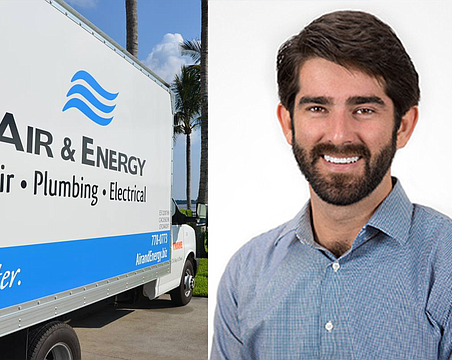Frost: Marketplace of ideas
Energy solutions? Media haven't a clue
In their efforts to influence public opinion, newspapers (and others) opposed to offshore drilling are doing a disservice to the American consumer.
By Weldon Frost
For many of us, newspapers, sometimes called the Fourth Estate, are the primary method by which the First Amendment is exercised in this country. Therefore, when they try to influence public opinion, newspapers should be fair, knowledgeable and correct when discussing a particular topic of public interest.
The Sarasota Herald-Tribune in recent weeks has used considerable space on its editorial page to oppose offshore drilling as an antidote to our $4-a-gallon gasoline prices. Its agenda and lack of knowledge require response.
Nowhere in the newspaper's discussions of energy that I saw did the word "conservation" appear. In a nation such as ours, where 5% of the world's population uses 25% of the world's energy, conservation should be at the top of the list of things we can do now. Whether it is turning up the air conditioner thermostat in public buildings, combining errands, car pooling, taking public transportation, turning out lights, down-sizing automobiles, etc., conservation should become a new and ever-conscious part of our lives.
This nation uses 48% of its energy constructing and operating buildings (both commercial and residential). How many times have you walked into a building or store or home and found the temperature to be just this side of snow flurries, cold enough to hang meat? Any chance there for energy savings?
Only 27% of our energy usage goes for transportation, and we are seeing already the effect of gas prices causing people to downsize their automobiles. Meaningful mileage standards would help, as would a reduced speed limit on the interstate system. The increased use of railroads to transport goods would also be helpful.
Industry uses 25% of our energy, and most industries have long since sought ways to use their energy more efficiently to improve their profits. Because the cost of all forms of fossil-fuel energy have risen substantially, there may be some room for further investment in energy-saving procedures. Oil refineries in particular, or plants that use a lot of energy, are always looking at ways to make their energy use more efficient.
As to the inference that opening up new areas to drilling would not add new supply until 2030, this is pure nonsense. I don't care what Washington-bound, government office-jockey at the Energy Information Administration makes such a pronouncement. I can tell you from first-hand experience that our oil industry can bring new supplies on production quicker than 22 years, onshore, offshore, shallow water, deep water or North Slope tundra.
Just look at the increase in production (also read decrease in imports) during the years 1980 to 1985, following the Iranian oil crisis. Drilling activity decreased in 1985 because the price of oil dropped to $10 a barrel. But the experience shows that drilling companies and oil companies can shift rigs halfway around the world in a matter of months.
Offshore drilling
Drilling offshore Florida is not the Big Bogeyman that many so easily imagine. There hasn't been a blowout in the Gulf of Mexico since 1969. Meanwhile, thousands upon thousands of wells have been drilled in the Western Gulf. More than 4,000 production platforms have been installed, and thousands of miles of subsea pipeline have been laid. Billions of barrels of oil and trillions of cubic feet of natural gas have been produced. Fifty thousand people work in the industry.
What's more, when Hurricanes Katrina and Rita knocked over or damaged more than a hundred producing platforms, pollution was not an issue. Each well has a down-hole safety valve to close in the well. In fact, recently published figures show that oil found floating in the ocean and on the beaches comes 63% from natural sea-bottom seeps, 32% from boating and run-off from onshore, 4% from oil tankers and 1% from offshore drilling/production.
In short, to tap the unknown reserves in this country while we transition to another paradigm of energy supply and usage, we must start drilling sometime. The sooner we start exploring and exploiting all of our resources in these new areas the better we all will be.
World oil reserves are constantly changing. New fields are discovered, and new concepts of prospect types are developed while the productivity of old fields naturally declines. Within the past 40 years, world reserves have changed markedly as a result of a drilling boom underpinned by remarkable advances in seismic technology. Reserves increased in the United Kingdom, Norway, Nigeria, Angola and Brazil, to name a few. Equatorial Guinea and Ghana became producers. Canadian oil sands have begun to be exploited. Fields are being discovered in 5,000 to 7,000 feet of water in the western Gulf and are being brought on production.
On the other hand, reserves have declined in one of our important suppliers, Mexico, because of a lack of focus on exploration and drilling and government mismanagement. Many producing countries are experiencing a decline in reserves due to inadequate drilling.
Published figures for OPEC reserves, by the way, are not reliable. The reserves of the various national oil companies are not transparent, being closely guarded by the national parent. For example, when ARAMCO was operating the Saudi Arabian industry, the American owners in 1979 announced reserves for the country of 110 billion barrels.
After the Saudis nationalized the operation and after OPEC announced in the 1980s that OPEC quotas would be set by the reserve estimates, Saudi reserves magically ballooned over a period of years to 260 billion barrels without any new major fields being discovered. That is the figure we see today. Meanwhile, almost 80 billion barrels have been produced and sold.
Something like this used to be called "creative" accounting.
Those 68 million acres
The term "reserves" covers proven reserves, probable reserves, possible reserves and speculative reserves (or undrilled exploration prospects). Only the first two categories are defined by having a well bore drilled into the reservoir rock. The latter two categories are mental images of what might be recovered. Hence the need for drilling to confirm whether the hydrocarbons are economically recoverable.
One of the most ridiculous assertions is the presumption that because the energy industry has 90 million acres under lease and only a quarter of that number is actually covering productive fields that 68 million acres is available for the companies to explore. This really shows ignorance of Mother Nature and how the oil industry operates.
Consider: Company A bids $20 million for a 5,000-acre block in the Gulf of Mexico, beating out in the sealed competitive bidding Company B (and others) by $5 million. The block may cover a defined prospect of, say, 650 acres. The lease may be valid for five, eight or 10 years.
Given the time-value of money, Company A is going to drill that prospect as soon as it can do some detailed-seismic research - maybe 3-D seismic - to pick an optimal location and line up a rig to drill the wildcat well. That will happen within six months to a year at most.
If the wildcat is a dry hole, Company A will record the $20 million bid as an expense on its next tax return. If the wildcat is successful in finding oil or gas, Company A capitalizes the $20 million and amortizes the $20 million bid on a unit-of-production basis. Therefore it is in Company A's interest to get that hydrocarbon deposit on production as soon as possible - because of the time-value of money. Meanwhile, under the terms of the lease, the entire 5,000 acres are "Held By Production."
The remainder of the 4,350 acres on that block will be surveyed seismically and reinterpreted several times on digital work stations before the geoscientists give up looking for another prospect on the block. They will look for any indicator that might justify another wildcat well.
Having spent $20 million to get the block, they are darn sure not going to sit long on any undrilled prospects - again the time-value of money. Therefore, the 68 million acres of undrilled lease-acreage held by companies are probably 90% goat pasture or shrimp pasture, but certainly the companies are not purposely covering up a bunch of undrilled prospects. Not every square foot of the world is underlain by an oil or gas field.
Should a competitor find a deposit in a new play on a nearby block, the re-interpretation of that 4,350 acres will be done all over again, and again, looking for a similar prospect on the lease block. Oil companies don't keep something up their sleeve by holding a lot of undrilled, unproductive acreage. At least not in the company that I worked for, or any that I knew about.
What's the alternative?
If we do not drill for oil or natural gas, I would like to know the "cost-effective," alternative energy sources that those opposed to drilling always talk about. How much energy they are going to provide?
Data of which I am aware says our country is nearly built out for hydroelectric dams (6% of our electricity). If the entire Midwest were covered with windmills, we might get another 6% or so of our electric needs by 2020; geothermally generated electricity could provide perhaps 2% of our electric needs. Oil from shale in the Piceance Formation of Colorado, Wyoming and Utah may be recovered through new techniques for sub-surface retorting, although the Senate just killed further leasing in that area. Solar energy capture is an area that desperately needs attention and research, for the Sun is, always has been and always will be the ultimate source of all energy - along with nuclear.
Corn-based ethanol is a political swindle on the public - being a farm subsidy program, not an energy program - because it takes more energy to produce the ethanol than it delivers. Furthermore, ethanol-juiced gasoline gives fewer miles per gallon and is harmful to the environment as well as to automotive fuel systems. Hydrogen also takes more energy to produce than it delivers.
That leaves nuclear. We should go get nuclear as soon as possible to supply those electric cars that should be on the way. What's more, there hasn't been a fatality in the nuclear-power generating business ever. And don't forget coal-to-gas and coal-to-liquid plants, to be built near oil fields so that the carbon dioxide can be sequestered and pumped into old oil fields to increase their ultimate recovery by 15% or 20%. Most people are unaware that one of the two cleanest coal-generating plants in America is in Mulberry in Polk County.
Coal to gas to turbine to electricity. Slick. Clean.
The aggressive use of the tax code to encourage responsible energy alternatives would speed up the transition to a new paradigm of energy generation and usage.
I must conclude, from my perspective, newspapers and others opposed to offshore drilling are failing us when it comes to helping the public form a good understanding of what needs to be done to resolve our energy crisis. Being against drilling offshore Florida or in ANWAR for no good non-political, technical or environmental reason does not help getting the public behind the required actions to move the country forward and out of its current mess.
Weldon Frost of Longboat Key is a geologist and former Vice President and Exploration Manager for various Mobil Oil overseas and domestic affiliates, including Libya, Indonesia (onshore and offshore), New Orleans (offshore Western Gulf of Mexico), and U.K. (North Sea offshore).





